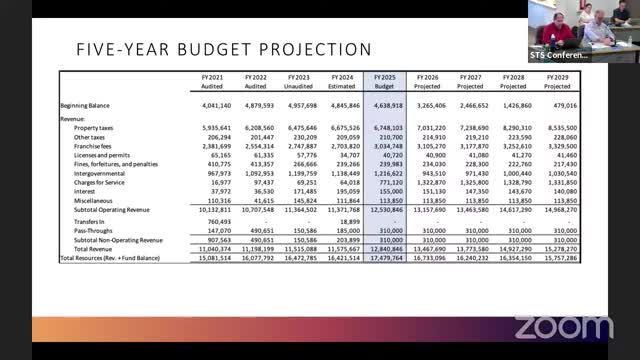City faces budget crisis as resources dwindle by 2029
August 29, 2024 | Lebanon, Linn County, Oregon
This article was created by AI summarizing key points discussed. AI makes mistakes, so for full details and context, please refer to the video of the full meeting. Please report any errors so we can fix them. Report an error »

In a recent government meeting, officials discussed the city's financial outlook, revealing a concerning trend of declining resources and increasing expenditures over the next five years. The beginning balance for the current budget year is projected at $479,000, which officials indicated will not suffice to cover expenses by the end of the fiscal year.
The discussion highlighted a conservative estimate for property tax growth, with a modest 3% increase anticipated for 2026 and 2027. A notable bump in revenue is expected in 2028, attributed to the early payoff of debt by the northwest urban renewal district, which could release an additional $350,000 in property tax revenue. However, this increase is not seen as a long-term solution to the city's financial challenges.
Other revenue sources, including lodging and marijuana taxes, are also projected to grow slowly, but officials cautioned that marijuana tax revenues may not be sustainable in the long run due to market saturation. Franchise fees and intergovernmental revenues from services provided to neighboring cities are expected to increase, but overall, the city's total resources are projected to decline from nearly $17.5 million in 2025 to approximately $15.8 million by 2029.
On the expenditure side, personnel costs are rising, with health insurance projected to increase by about 6% annually. The city anticipates a significant rise in salaries due to collective bargaining agreements, while materials and service costs are expected to outpace the currently budgeted 1% increase, potentially leading to cuts in services.
By 2029, total expenditures are estimated to reach $16.5 million, exceeding the projected resources and resulting in a deficit of $742,000. The city is required to maintain a reserve of 17% of annual expenditures, which further complicates the financial outlook, indicating that by 2027, the city may not have sufficient funds to meet its fiscal obligations.
Officials acknowledged the gravity of the situation and encouraged further discussion on potential solutions to address the impending budget shortfall.
The discussion highlighted a conservative estimate for property tax growth, with a modest 3% increase anticipated for 2026 and 2027. A notable bump in revenue is expected in 2028, attributed to the early payoff of debt by the northwest urban renewal district, which could release an additional $350,000 in property tax revenue. However, this increase is not seen as a long-term solution to the city's financial challenges.
Other revenue sources, including lodging and marijuana taxes, are also projected to grow slowly, but officials cautioned that marijuana tax revenues may not be sustainable in the long run due to market saturation. Franchise fees and intergovernmental revenues from services provided to neighboring cities are expected to increase, but overall, the city's total resources are projected to decline from nearly $17.5 million in 2025 to approximately $15.8 million by 2029.
On the expenditure side, personnel costs are rising, with health insurance projected to increase by about 6% annually. The city anticipates a significant rise in salaries due to collective bargaining agreements, while materials and service costs are expected to outpace the currently budgeted 1% increase, potentially leading to cuts in services.
By 2029, total expenditures are estimated to reach $16.5 million, exceeding the projected resources and resulting in a deficit of $742,000. The city is required to maintain a reserve of 17% of annual expenditures, which further complicates the financial outlook, indicating that by 2027, the city may not have sufficient funds to meet its fiscal obligations.
Officials acknowledged the gravity of the situation and encouraged further discussion on potential solutions to address the impending budget shortfall.
View full meeting
This article is based on a recent meeting—watch the full video and explore the complete transcript for deeper insights into the discussion.
View full meeting
